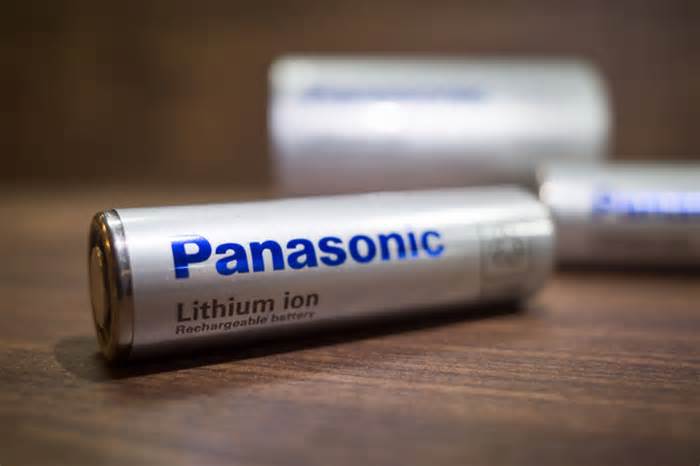Panasonic Holdings Corp. plans to roll out the newest iteration of its electric vehicle battery cells with improved capacity as early as this calendar year, the chief technology officer for EV batteries said.
A revamped version of its 2170 cells will begin production at its manufacturing plant in Nevada sometime during 2024 or 2025, CTO Shoichiro Watanabe said in an interview.
The Osaka-based electronics maker can deliver on its promise to quadruple production capacity by the 2030 fiscal year, according to Watanabe, and it doesn’t need to rely completely on building a new factory or heavy investments to do so. Panasonic has been working to boost the energy density of the 2170 cell, Watanabe said, adding that it could help reduce the overall cost of an electric vehicle.
“We’re going to increase battery capacity and productivity at the same time,” Watanabe said.
Panasonic set its sights on North America, with plans to improve and expand production there as part of its goal to one day provide 200 gigawatt hours of energy in electric vehicle batteries. Panasonic is also developing another battery that’s thicker and more voluminous, called the 4680 cell.
According to Watanabe, expanding production capacity by up to 10% by fiscal year 2025 necessarily requires the addition of new production lines or more investments. Decisions on the production schedule of batteries for next-generation electric vehicles at the Nevada plant, which is jointly operated with Tesla Inc. . , will be done “unilaterally, but together,” he said.
Panasonic has invested heavily in the development of batteries for electric vehicles to ensure that it is not left in the global fight to phase out fossil fuels and move to clean, carbon-neutral energy sources.
Panasonic’s stocks fell less than 1% on Monday morning in Tokyo. Stocks have remained largely unchanged this year, after 26% last year.
It’s currently building a battery plant in Kansas—its second in North America—and will reveal the location of a third by the end of this fiscal year ending March. The company has pledged to raise its battery production capacity to 200 GWh by the 2030 fiscal year from its current limit of 50 GWh.
While Watanabe declined to comment on the long-term location of the next plant, he said the operation of the new facility “will require thousands of employees. “
Panasonic said in December it had turned down almost $700 million in state incentives to build a manufacturing site in Oklahoma.
Earlier that month, Panasonic announced an agreement to buy nano-composite silicon anode material from Sila Nanotechnologies Inc. The materials will be obtained from Sila’s facility in Washington state as Panasonic looks to strengthen its battery supply chain in North America.
“Decisions about where to position new facilities are extraordinarily complex and are based on a wide range of factors,” a Panasonic spokesperson said, adding that the decision won’t impact operations in Nevada or Kansas.
The Biden administration’s Inflation Reduction Act provides subsidies for U. S. -made battery cells, offering credit to global brands like Panasonic, which projects an accumulation of 85 billion yen ($587 million) in its operating profit in the monetary year ending March 2024.
Japan took its own resolution in 2022 to foster a domestic market by pledging to increase the annual production capacity of lithium-ion batteries to 150 GWh by 2030. Although Panasonic doesn’t make cars, it is the largest battery manufacturer in the country and Subaru’s main supplier. Corp. , Mazda Motor Corp. , and Telsa.
Regarding Japan’s efforts to increase domestic production, Watanabe said that “if possible, the ideal would be to manufacture them ourselves. “
Input your search keywords and press Enter.

